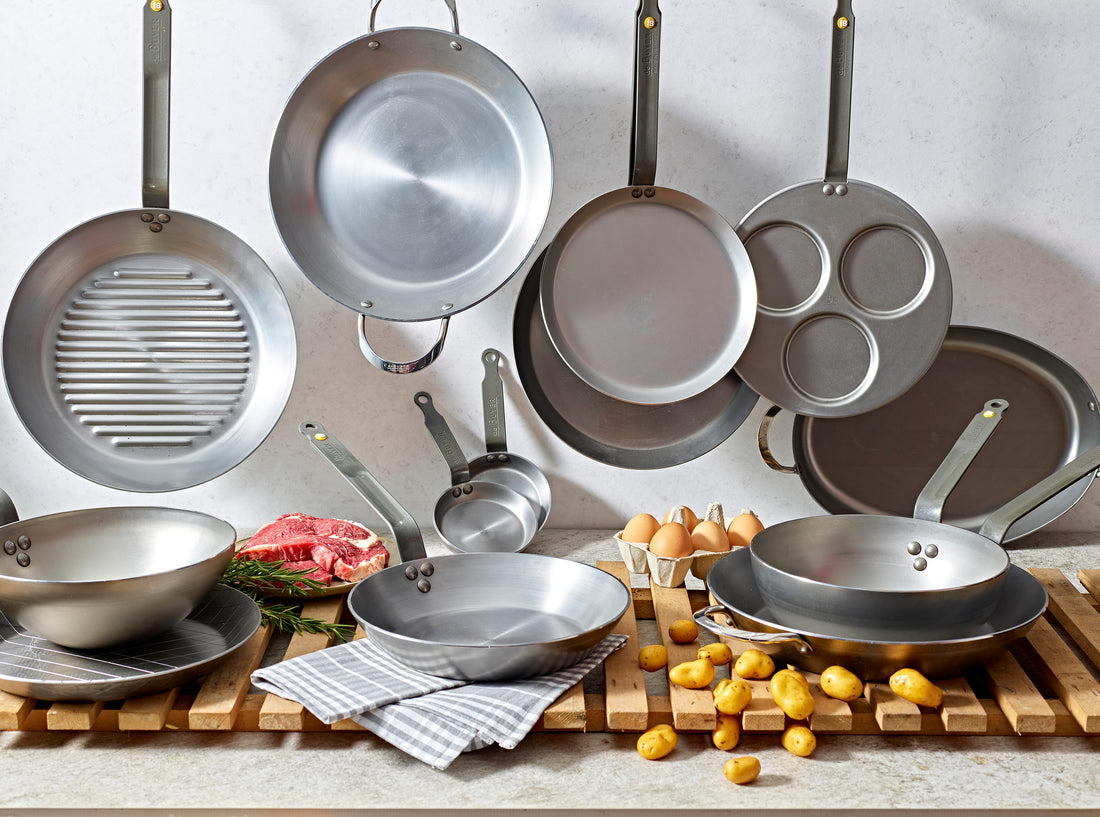The things to consider when choosing a frying pan are:
1) Material
2) Size
3) Price
Material
The material is perhaps the most important aspect and your choice should depend on what you mostly use the frying pan for. Carbon steel and cast iron are both excellent for frying at high temperatures. That means food where you want a nice browned result, e.g. a steak. The carbon-steel pan is also suitable for quick frying, such as a French omelette, but iron and carbon-steel pans are less suitable for simmering and carefully warming up food at a low temperature.
Carbon steel is essentially iron with a small percentage of carbon and the pans are made in a press rather than a mould.
Both carbon-steel and non-enamelled cast-iron pans should be seasoned before the first use. Their non-stick properties improve with use and it is important to understand that the pan will get better over time. The carbon-steel pan is lighter and tends to become ready to use quicker than a cast-iron pan.
Both are very good heat conductors and, since iron is a magnetic metal, they work well on induction. The carbon-steel heats up - and cool down - faster than the cast-iron pan. Cast iron retains heat for longer, which can be an advantage in e.g. a grill pan or a stew pot.
These iron pans are often compared with non-stick pans, perhaps the most common of all frying pans. A non-stick pan is easy to use, doesn't need and seasoning and is generally lighter than other pans. The drawbacks are that it does not last forever: how long it lasts depends on the quality of the surface treatment, and it is not suitable for frying at high temperatures. A non-stick pan is therefore excellent for heating up food and for delicate frying, but will not produce the same browned reuslt as an iron or carbon-steel pan. Our top range of non-stick pans, De Buyer's Choc Extrême, is made of cast aluminium and has a coating of seven layers. A Choc Extrême will last for a year in restaurant use and should last several years in home use.
Stainless-steel pans are an option for those who want to avoid coated pans. Stain-less steel is in itself a very poor heat conductor and these pans therefore have one or more interior layers of a heat-conducting material, most often aluminium. Standard pans have a body of thin stainless steel and a thick sandwich bottom, which conducts the heat from the source to the pan. High-end pans are built in one piece, where the heat-conducting layers extend throughout the pans so that the heat is distributed not only from the bottom but also from the side. These are for instance De Buyer's series Affinity and Alchimy. The Prim'Appety range has a standard sandwich bottom and is a good alternative for any budget.
Stainless-steel pans are long lasting and easy to care for. They are dishwasher safe, although you should be careful not to overdose with detergent which can be corrosive and damage the surface in the long run. Stainless-steel pans are excellent for low and medium temperatures.
The top end of frying pans, saucepans and stewpans is copper. Copper is a wonderful material to work with because it conducts heat so well. That means that it is easy to regulate the temperature quickly while you cook. The drawback is the price: these pans are at the very top end of the scale. Do not put your copper pans in the dishwasher - they will turn green. Copper develops a beautiful patina and can be cleaned with metal polish when the mother-in-law comes to visit.
Copper is not magnetic so does not work on induction automatically. De Buyer's Prima Matera range has a magnetic insert in the bottom to make it induction compatible.
Size
Frying pan sizes are given as the top diameter. A 28 cm pan thus has a base of c. 20 cm. When you choose the size you want, of course, to have a big enough pan to handle the amount of food you normally cook, but on the other hand you don't want the pan to be too heavy and unwieldy. A 28 cm is often a good choice for an allround pan. The larger 32 cm pan is handy for larger parties but is often too heavy for everyday use. A 24 cm pan is perfect for a French 2-egg omelette and useful for small amounts of food and side dishes.
Price
The prices of frying pans cover a large span. You can get a decent pan for 30 € whereas a copper pan will cost ten times that or more. Remember that a frying pan is something you will use every day and, if it is a copper or carbon-steel pan, will last your whole life.
